
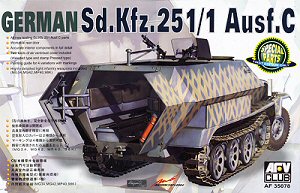
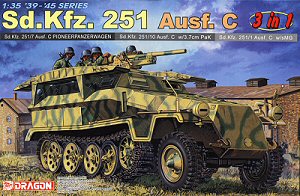
Sd.Kfz. 251/1 Ausf. C
Kit Comparison
AFV Club #AF 35078 - Dragon #6224
1:35th Scale
Kit Comparison by Terry Ashley



Review Update:
I have updated this comparison to take into account
the updates included in the later Ausf.C kits from both AFV Club and Dragon.
I can only assume these updated details will find their way into earlier
kits as they are produced, but I have no evidence this is happening as I
can't afford to keep buying a new kit every now and again just to see if
bits are updated. New text added is in red to help you identify what's new.
While it is good that Dragon is updating/correcting parts in each new release it also creates a minefield for the model buyer as you don’t know if the new parts are being included in earlier kits and if so how do you know when buying a kit if it has the updated parts or the original?
But anyway let’s move on and see how the most recent released Dragon 251 Ausf.C kit (#6224) stacks up with the new AFV Club Ausf.C (#AF 35078) also just released?
For this review I will be looking at the base 251/1 Schützenpanzerwagon only and comparing the kits strictly on a detail by detail basis as obviously the Dragon kits have the many variant options and extra parts included which the AFV Club kit does not and there are also many reasons why a person will buy a particular kit other than the level of detail such as their budget, options offered, availability etc.
I have also included many images that hopefully will illustrate the text below from where you can make your own decisions about the kits with the AFV Club parts shown in olive green plastic and the Dragon parts in light grey plastic and also note that the parts have been removed from the sprues for the images to better show the parts.
Lower Hull:
 Starting from the ground up the breakdown of the lower hulls is treated differently
on each kit with AFV Club (AFV) including the road wheel axle mounting
plate as part of the side hull panels while the Dragon (DR) kit has a separate
lower hull part with the hull side panels as separate parts. Both kits
have separate axles and bump stops for the suspension so you articulate
these if you wish.
Starting from the ground up the breakdown of the lower hulls is treated differently
on each kit with AFV Club (AFV) including the road wheel axle mounting
plate as part of the side hull panels while the Dragon (DR) kit has a separate
lower hull part with the hull side panels as separate parts. Both kits
have separate axles and bump stops for the suspension so you articulate
these if you wish.
The lower sections of the engine are included with the lower hull part on the DR kit but with the lower floor part on the AFV kit but they both arrive a the same end result while at the rear the AFV kit has the complete upper and lower hull plates as a separate part while the DR kit has only the lower section as a separate part with the upper hull panels included in the main hull moulding. This highlights one major difference on the overall finish in that the AFV kit has the correct upper hull overhang when attached to the lower hull while the DR kit has the upper and lower panels butting together evenly. The lower rear panel with the towing shackle is also a separate part on the AFV kit with much better detail than that on the DR kit which has the lower panel moulded with the lower rear hull panels.
We should of course mention the gearbox, battery, fuel tank and rear axle in the lower hull tub of the DR kit even though this can’t be seen on the assembled kit and I still haven’t worked out why it’s there, but that’s not a criticism as you can simply bypass these during assembly.
The detail definition around the lower hull axle mountings is far more detailed on the AFV kit with a raised reinforcing panel with recesses around the bump stops and also on the hull sides is the fender attachment flanges which are not present on the DR kits. From references this raised reinforcing panel seems to be a later modification as early photos of the chassis don’t have this feature, and I’m open to more info on this?
Running Gear/Suspension:
 There were different styles of front wheels used on the 251 series and both
kits included what could be referred to as the most common type with the
detail on the AFV kit having good definition although they don’t
have the tyre valve fittings while on the DR wheels there have now been
three different wheel designs with minor detail differences including two
variations on the tyre valve fitting and what appears to be a counterweight,
but overall the AFV wheels are more refined. The tyre tread pattern is
different on both wheels but I’ve seen images with both tread types
so there is really no problem here.
There were different styles of front wheels used on the 251 series and both
kits included what could be referred to as the most common type with the
detail on the AFV kit having good definition although they don’t
have the tyre valve fittings while on the DR wheels there have now been
three different wheel designs with minor detail differences including two
variations on the tyre valve fitting and what appears to be a counterweight,
but overall the AFV wheels are more refined. The tyre tread pattern is
different on both wheels but I’ve seen images with both tread types
so there is really no problem here.
The road wheels are also more refined on the AFV wheels with the spot welds around the outer wheel rims and the subtle curve around the edges of the lightening holes and raised sections around the lightening holes on the inner wheels while on the drive sprockets the AFV parts are again more detailed with the correct offset of the drive teeth and the rollers included on the drive teeth while the teeth are not offset nor do they have the rollers on the DR sprockets, again the drive teeth in this latest kit have additional details added but are still not offset as they should be. This may only be a minor point as this offset is really not as noticeably on the 251 sprockets as it is on the bigger FAMO for example but it should be there.
It has been reported that the drive sprockets on the latest DR 251/22 kit have been reworked further so will have to wait and see how far the improvements have gone?
The front suspension units are multi-part on both kits with the DR parts
being much finer than the AFV parts but on referring to available plans the
DR parts are a little undersized with the AFV parts being closer to the sizes
indicated.
The AFV axle stubs are fixed in place while the DR stubs are designed to
be steerable after assembly which is handy to include a bit of animation
to the finished model or when used in dioramas. The AFV kit also has the
left side steering arm which is not present in the DR kits.
Overall the lower hull and running gear/suspension detail is far more detailed and refined on the AFV kit but the simpler breakdown of parts on the DR kit will probably result in an easier build.
Tracks:
Another major difference in the kits is with the tracks where you get individual
link working track in the DR kit and simple vinyl ‘rubber band’ track
with the AFV kit and while this has nice details for this type of track
doesn’t have the definition of the DR individual link track.
The fact that AFV offer separate individual link track sets is really irrelevant in regards to the comparison but they are available if you wish to shell out extra cash to update the tracks.
Upper Hull/Fenders:
 The upper hull in both kits is a single moulding with separate engine bay
doors, open vision ports on the front and side ports (the DR kit from this
kit only) as well as separate upper hull visor and top panels with subtle
weld seams on each kit with the main difference being the treatment of
the rear hull panels as mentioned above and again the lack of hull overhang
on the DR kit quite noticeable.
The upper hull in both kits is a single moulding with separate engine bay
doors, open vision ports on the front and side ports (the DR kit from this
kit only) as well as separate upper hull visor and top panels with subtle
weld seams on each kit with the main difference being the treatment of
the rear hull panels as mentioned above and again the lack of hull overhang
on the DR kit quite noticeable.
The separate rear hull section on the AFV kit also allows the rivet details above the rear doors to be better represented with another difference the AFV kit providing alternate welded and cast front armoured intake covers while the DR kit has only the welded type.
Both fenders are separate single length mouldings with again the AFV parts being far more detailed than the DR fenders with the small bolt head details around the panel joins and hull attachments and also detail around the exhaust mounting brackets while the DR fenders were quite plain in the initial kits but have been updated with the inclusion of bolt head details as with the AF kit and real fenders for a better look.
The fender storage boxes on the AFV kit are single close mouldings while from this kit DR have re-worked theirs to have separate doors that can be shown open or closed as you wish. The pioneer tools on each kit could benefit with the tool clips being replaced with etched items for a better appearance but other than that are much of a muchness.
Also provided in both kits are formed brass width indicators for the fenders with the AFV parts matching available plans with the DR parts being slightly longer although the difference is probably unnoticeable when the indicators are in place and they are much finer than the plastic parts.
Interior:
 On the interior both kits represent the upper side panels for mounting the
sidewall equipment as raised panels on the inner hull sides and have full
length floor sections with tread plate pattern included. The rear floor
section on the AFV kit is a separate part to allow for the variations
in equipment but the forward central hump is quite noticeable undersized
on
the DR kit when comparing to photos of the vehicle interiors with the AFV hump
being more to the correct size.
On the interior both kits represent the upper side panels for mounting the
sidewall equipment as raised panels on the inner hull sides and have full
length floor sections with tread plate pattern included. The rear floor
section on the AFV kit is a separate part to allow for the variations
in equipment but the forward central hump is quite noticeable undersized
on
the DR kit when comparing to photos of the vehicle interiors with the AFV hump
being more to the correct size.
The forward engine bulkhead/instrument panel is the incorrect shape on the DR kit with both lower walls being vertical while the left side wall should be slanted outward as represented on the AFV kit. This bulkhead/instrument panel on the DR kits has been updated with revised instruments and simulated left side offset, although the wall itself is still vertical. The engraved detail on the instrument panels is quite well done on each with the panel and lower piping being separate parts on the AFV kit. The driver’s foot pedals are very basic flat ‘blocks’ on the DR kit while the pedals are separate parts on the AFV kit for better definition and three gear levers also have more refined details on the AFV kit.
The other major issue here is the positron of the bulkhead which is far too back in the DR kit while at the correct forward position in the AFV kit, this may be the reason the central transmission hump is so small in the DR kit to compensate for not having enough room to show it the correct size due to the incorrect bulkhead position.
Both kits have the separate large bolted flanges between the forward and rear hull sections but investigation has revealed that the shape of the AFV flanges matches available photographs while the DR flange has the incorrect contours at the bend and the bolts are not central on the DR flange as they should be while they are on the AFV flanges. A number of drawings in the Ground Power 251 Special show the contours of the DR flange on the Ausf.C but I have not found any photographs to back this up, while I have one photo of an Ausf.C interior which has the AFV style flange. The upper hull plate with padded head guards on the underside and grab handle on the rear edge with top machine gun shield in one piece and separate bullet splash fillet is included on both kits.
The crew seats on the AFV kit have nice cushion detail and securing tabs around the seat frames as sell as separate lower seat sections while the seats in the DR kit are quite large with basic details with the lower rear seat joined as one assembly. The DR seats have been updated with the inclusion of etched rear springs for added detail although the seat shape is still the same and slightly undersized. The steering wheel column is also better detailed on the AFV kit with a fairly basic part on the DR kit and overall the lower and forward details are again much more detailed and refined on the AFV kit than on the DR kit which has a few dimensional errors apparent.
The visors are again multi-part in both kits with nice details with the new clear parts in this DR kit offering slightly better detail definition and both can be positioned in the open or closed position, DR have also opened up the two side wall visor ports in this kit so both have the four ports open. The AF kit has beed updated with clear green tinted parts for the vision blocks to go along with the clear parts in the DR kits.
Both kits have the two leather covered rear crew seats with backrest storage boxes and rifle racks and again there isn’t much between the two in this area as well as side wall mounted equipment such as MP40 and other fittings and again is much of a muchness here.
At the back are the separate doors with the fire extinguisher mounting while
the AFV kit also has the rear wall mounted MG ammo racks which aren’t
on the DR kit.
The big difference here is in the size and shape of the frame door hinges,
with the AFV hinges being noticeable larger, thicker and a different shape
than those in the DR kit.
I have checked many photos and have seen vehicles with both types of hinges
but both seem to have slightly the wrong shaped bend, while the AFV seems
a little oversized while the DR a little undersized, but as I don’t
have definitive info on this the jury is still out and if anyone has more
info on the hinges shape and sizes I would be very glad to hear from you,
thanks.
Weapons:
The standard weapons in the 251s are in the form of Kar98K rifles and MG34s
plus the MG42 in the AFV kit.
The standard of these weapons is simple superb being some of the best you
will find in any standard plastic kit with the AFV weapons being fractionally
ahead of the DR if you wanted to get real picky but it’s that close
that it’s really note worth talking about.
Conclusion:
As stated this comparison is strictly on the base 251 vehicle only and on
that level the AFV kit has clearly better defined details overall
with some dimensional issues in the DR kit such as the forward
engine bulkhead position, central floor hump size, seats, front suspension
and lack of hull overhang as well as other areas
of no driver foot pedals and lack of details on the fenders and drive sprockets
all of which are correct and nicely rendered on the AFV kit.
Even with the updated parts in the DR kits, the AF Ausf.C kits are still IMHO the more accurate and better detailed overall.
Areas where the DR kit comes out on top are the tracks and choice of open fender storage boxes and new clear vision ports and the DR kit will probably provide an easier build due to the engineering in a few areas compared to the AFV kit.
While the AFV kit has better defined details, it is not to say the DR kit won’t build into an attractive model as it certainly will with both kits having the basic shape and dimensions of the 251 down to a tee and the fit of parts being very good.
But of course the big attraction of the DR kits is all the extras like the other /7 and /10, sMG versions offered in this kit as well as the bonus figures and equipment and relatively cheap price that may see many overlook the finer detail issues and go with the DR kits which do offer good value for money.
Personally, I have bought all the DR 251 kits so far and will certainly be getting the new ones simply due to the number of vehicle versions and options offered but will also get all the AFV kits for the finer details and if the budget allows why wouldn’t you? But if Dragon would concentrate more on quality than quantity we would all be that much more appreciative.
As a final note, this comparison is based on the basic 251 vehicle kits as they are at the date of posting and when the next DR kit appears I may have to revise a number of areas.
Also see the comparison review of the Sd.Kfz.251/7 Ausf.C Pioneer kits from AFV Club and Dragon.
References:
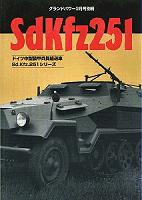 SdKfz251 Ground Power Special GALILEO Publishing Co.,Ltd |
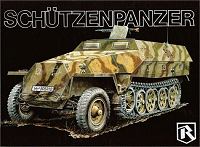 Schutzenpanzer (Armored Personnel Carrier) Ryton Publications ISBN: 1930571291 |
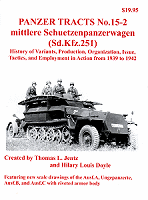 Sd.Kfz.251 1939 to 1942 Panzer Tracts No.15-2 Covers /1 to /10 |
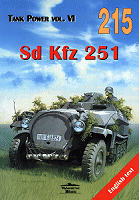 Sd Kfz 251 Tank Power Vol.VI Wydawnictwo Militaria No.215 ISBN: 83-7219-215-4 |
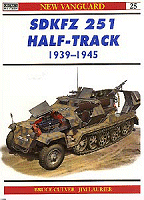 Sdkfz251 Osprey New Vanguard 25 |
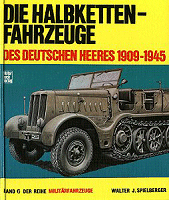 German Halftracks 1909-1945 Spielberger Book 6 |
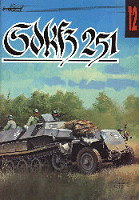 SdKfz251 Wydawnictwo Militaria No.12 ISBN: 83-86209-06-2 |
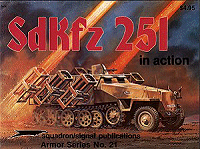 SdKfz251 in action Squadron Signal #2021 |
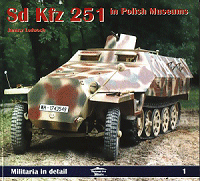 SdKfz 251 Militaria in Detail 001 ISBN: 83-7219-061-5 |
Page created November 15, 2004
Updated November 28, 2004
(Updates in Italics - Interior)
Updated October 22, 2005
(updates in red)